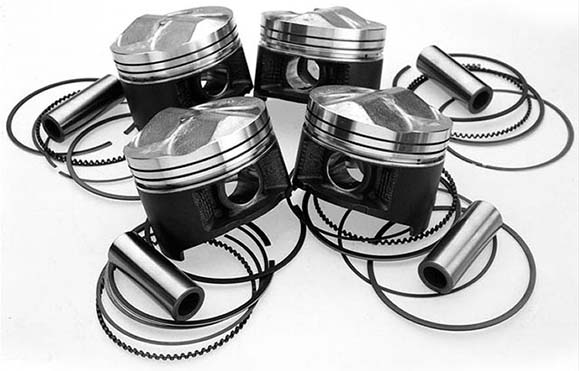 Why coat engine pistons
Why coat engine pistonsHigh Performace Coatings for Engine Pistons
A must for any serious engine! Piston coating is essential for high performance engines and today it is unusual to see a high end race engine of any description that does not use this technology. Since horsepower and temperature seem to go hand in hand, that is to say the higher the horsepower of any given engine, the natural by-product of this is heat and the key to maintaining engine power and long-term integrity is to manage the excess heat effectively. The top teams in most forms of motorsport all depend on specially configured engine parts and coating combinations to optimize the trade off between horsepower and temperature and Hi Octane performance coatings is at the forefront of this technology.
The skirts. Molybdenum Disulphide dry film lubricant Piston coating is the process of applying a dry film lubricant to the piston skirt, which reduces friction by up to 60%, attracts oil and keeps engine temperatures down during high performance operation. This process has become commonplace in any high performance application with some piston manufacturers now applying this as a standard practice. Antifriction piston coatings increase horsepower and piston life by evenly controlling part expansion, while reducing friction and part temperature.

The Crown. CBC2 Ceramic coating (CBX for alcohol, supercharged and Nitrous applications)
Piston coating doesn't end with the antifriction process. Cutting-edge piston function often requires the application of a reflective coating to the top of the piston, which reflects heat into the combustion chamber and improves engine operation, particularly in high compression or boosted engines.
Known as thermal barrier coating, this process will not only reduce piston temperatures and increase reliable part life, but the engine will experience improved combustion and performance as a result of heat being reflected back into the fuel charge. In addition to the piston crown, these thermal barrier coatings can be applied to the valve face, stem, exhaust port and combustion chamber, which contribute to increased exhaust gas velocity and greatly improved engine scavenging potential.

By applying HPEC's TLTD to the underside of the piston, oil that is splashed onto the piston to cool it will shed rapidly. Heat transfers most rapidly when there is a large difference in temperature. The longer oil clings to a hot surface the hotter the oil becomes. By shedding the cooling oil more rapidly, cooler oil is splashed over the surface more frequently. If the oil "hangs" longer, it absorbes less heat and blocks cooler oil from contacting the hot surface. A cooler piston grows less, allowing tighter piston to wall clearances.
